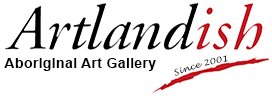Kitja Artists of the Kimberley Region
Normally spelt Kija or Gidja, we believe the correct spelling is Kitja. The letter ‘K’ in Aboriginal language is pronounced ‘G’ and ‘T’ is pronounced ‘G’ i.e. “Kartiya” pronounced “Gudia” = whiteman.
The Kitja country in the Kimberley is huge in mass, rugged, harsh, unforgiving, breathtakingly beautiful from Purnululu and the Jaru speaking people of the desert South, right up the Gibb River Road to the Woolah tribe country just ask Sade Carrington or Churchill Cann they will give you not only the description of the expanse of land, but the mileage between important places, the topography, the Dreaming stories associated with the landmarks as will Patrick Mung Mung, Peggy Patrick, Sandy and Madigan Thomas, Henry Wambini and many many others. This is the land they paint the land where they were born the land where they worked and hunted – the land they love.
Kitja people proud, determined, traditional, strong, enduring.
These people have touched the lives of many white people the early settlers the Duracks, the Quiltys, and Sam and Maggie Lilly of Bow River Station. All these people have written books about their association with the Kitja people and their close relatives of other skin groups and we note that, when we ask our Aboriginal painters (not just the Kitja people but ALL of our painters), about their life stories for their profiles they ALWAYS say .. I was born on Texas Downs, I worked on Landsdowne, I was Head Stockman on Bow River, I worked in the house for the missus on Argyle. Many take their names from the stations on which they worked – Carlton Hill, Rosewood, Newry, Nicholson.
Read Freda Wilson’s story (Mirriuwong tribe) on our site when she tells about the wonderful times she remembers when friends would travel many miles at “sitdown” time (the wet when station duties stopped) and the fun they had and at Christmastime when the station managers made sure the Aboriginal people had a Very Merry Christmas. Read Maggie Lilly’s story of her life with her late husband Sam and the close ties they had with the Kitja people, particularly the late Timmy Timms and Joe Thomas and families. As Maggie said at Tim’s funeral “Your family is my family, and mine is yours”. It is very apparent that the time spent on the cattle stations played a very important part in the lives of the Aboriginal people.
From Station life to Warmun (Turkey Creek) the Kitja people have had for many years a “base” at their Community at Warmun, two hundred kilometres south of Kununurra. Many live and work on the Community, which has a School, Pensioner Unit, Medical Facilities, Community Store, Church, sporting ovals and of course, their Art Centre at what used to be the old Police Station (and many of the senior Artists still say they paint at the “Police Station”).
Whilst Warmun is used as their main base, many live or spend a great deal of time on their own smaller communities in the immediate area Frog Hollow, where the late Jack Britten was Chairperson and retired with his old friend and fellow artist Henry Wambini; Crocodile Hole which is an excision of Bow River Station where Joe Thomas is Chairperson and his wife Phyllis Thomas has made her mark as a talented painter; Bow River Station, a million acre working cattle station with Mona Ramsay, another notable artist, running the station with the help of her family, all descendents of the late Timmy Timms; Violet Valley owned by Sandy and Madigan Thomas Madigan being one of the senior artists at Warmun; Norton Bore where Madigan’s eldest daughter Shirley Purdie and her husband Gordon Barney are Chairpersons and again, both well established artists; Lakewang with Lorna Thomas as Chairperson and again Lorna is not only a sought after painter but one of the best story-tellers in the region. Other communities include the beautiful Osmond Valley and Dolly Hole all part of the Warmun/Kitja country.
All these names are instantly recognisable in the Warmun Artists paintings:
- “Full Moon Rising Over Norton Bore” by Shirley Purdie
- “Walking Trails at Violet Valley” by Madigan Thomas
- “Rhatigan’s Bore Bow River” by Mona Ramsay
- “Eagle Hawk and Crow” by Katie Cox depicting a Dreamtime Story but painting the hills behind Turkey Creek.
Warmun artists have emerged as a devoted, talented group with a distinctive yet individual style they paint their land with incredible accuracy, the Ngarrangkarni (Dreaming) stories with great pride and they have the drive, enthusiasm and commitment to teach the younger painters technique, stories, and all the details of their culture. They are ochre painters sometimes thick, sometimes using the old technique of mixing with charcoal, outlining the landscapes with minimal dotting.
Most paint both for their Community and as Independent Artists with third generation painters now established, the artworld looks forward to the emerging fourth generation of Warmun painters, to see how they carry on their culture with their own modern style of contemporary Aboriginal art.

